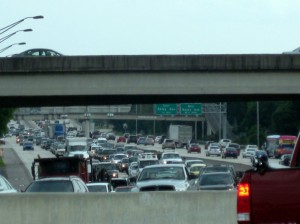Wider roads no answer to Orlando’s traffic congestion

A Texas A&M Transportation Institute study found that in 2010, urban congestion resulted in the release of 56 billion pounds of additional carbon dioxide in the atmosphere. Image by Freelancecrunch.
Everyone gets stuck in traffic congestion every now and then, but the reasons for jams vary. As you might imagine, Orlando’s traffic congestion is aggravated by tourists. While the past two decades saw roads being widened and new ones added, over 1,000 road stretches in the city won’t see further widening. Reasons behind this decision include rising costs and residents not wanting the increase in traffic that more lanes would bring.
But what about congestion costs? A Texas A&M Transportation Institute’s study reveals that in 2011, urban Americans traveled an extra 5.5 billion hours due to congestion. They also bought 2.9 billion more gallons of fuel, which added up to $121 billion.
Population growth and more tourists are only going to increase congestion in Orlando unless city planners encourage ridesharing and public transport (move more people per vehicle) and de-incentivize trips to shift the size and timing of rush hours (congestion pricing).
Orlando urban planners are now focusing on making the city more pedestrian friendly, cyclist friendly, and welcoming to bus users, all in the hope of reducing the number of motorists. This in turn will alleviate traffic and pollution problems in the long term.
“We are more focused on quality of life,” says Charles Ramdatt, Orlando’s chief transportation engineer. Like Los Angeles, Orlando has worked on timing traffic lights to ensure traffic keeps moving. Motorists, on the other hand, hope that new highways in the making could provide them some relief.

View this sign here.
The reality, however, is that these projects are a while away from completion-2021 to be exact and wouldn’t really solve the problem of congestion for hopeful motorists. Latent demand, or cars avoiding roads because they are crowded will return once traffic moves faster. Since then there will be more vehicles using the road, they will all travel slower and congestion will be back. “It’s a vicious cycle,” admits Renzo Nastasi, Orange County’s top transportation planner.
Using roads at off-peak times – one of the aforementioned solutions to relieve congestion – is more practical for retired residents or other groups not bound by business hours. Congestion pricing led to outrage when Los Angeles introduced it, so it seems likely it will provoke the same reaction when Orlando’s plans to add toll lanes to Interstate 4 go through.
Category: Infrastructure
















Comments (2)
Sites That Link to this Post